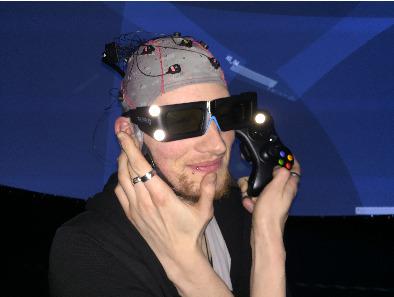当前位置:
X-MOL 学术
›
Comput. Animat. Virtual Worlds
›
论文详情
Our official English website, www.x-mol.net, welcomes your feedback! (Note: you will need to create a separate account there.)
Exploring neural and peripheral physiological correlates of simulator sickness
Computer Animation and Virtual Worlds ( IF 1.1 ) Pub Date : 2020-07-01 , DOI: 10.1002/cav.1953 Jan‐Philipp Tauscher 1 , Alexandra Witt 2 , Sebastian Bosse 3 , Fabian W. Schottky 1 , Steve Grogorick 1 , Susana Castillo 1 , Marcus Magnor 1
Computer Animation and Virtual Worlds ( IF 1.1 ) Pub Date : 2020-07-01 , DOI: 10.1002/cav.1953 Jan‐Philipp Tauscher 1 , Alexandra Witt 2 , Sebastian Bosse 3 , Fabian W. Schottky 1 , Steve Grogorick 1 , Susana Castillo 1 , Marcus Magnor 1
Affiliation

|
This article investigates neural and physiological correlates of simulator sickness (SS) through a controlled experiment conducted within a fully immersive dome projection system. Our goal is to establish a reliable, objective, and in situ measurable predictive indicator of SS. SS is a problem common to all types of visual simulators consisting of motion sickness‐like symptoms that may be experienced while and after being exposed to a dynamic, immersive visualization. It leads to ethical concerns and impaired validity of simulator‐based research. Due to the popularity of virtual reality devices, the number of people exposed to this problem is increasing and, therefore, it is crucial to find reliable predictors of this condition before any symptoms appear. Despite its relevance and the several theories about its origins, SS cannot yet be quantitatively modeled and predicted. Our results indicate that, while neural correlates did not materialize, physiological measures may be a solid early indicator of oncoming SS.
中文翻译:

探索模拟病的神经和外周生理相关性
本文通过在完全沉浸式圆顶投影系统中进行的受控实验来研究模拟器疾病 (SS) 的神经和生理相关性。我们的目标是建立一个可靠、客观和原位可测量的 SS 预测指标。SS 是所有类型的视觉模拟器的共同问题,包括在暴露于动态、沉浸式可视化时和之后可能出现的晕动病样症状。它导致基于模拟器的研究的伦理问题和有效性受损。由于虚拟现实设备的普及,暴露于此问题的人数正在增加,因此,在出现任何症状之前找到这种情况的可靠预测指标至关重要。尽管它的相关性和关于它的起源的几种理论,SS 尚不能定量建模和预测。我们的结果表明,虽然神经相关性没有实现,但生理测量可能是即将到来的 SS 的可靠早期指标。
更新日期:2020-07-01
中文翻译:

探索模拟病的神经和外周生理相关性
本文通过在完全沉浸式圆顶投影系统中进行的受控实验来研究模拟器疾病 (SS) 的神经和生理相关性。我们的目标是建立一个可靠、客观和原位可测量的 SS 预测指标。SS 是所有类型的视觉模拟器的共同问题,包括在暴露于动态、沉浸式可视化时和之后可能出现的晕动病样症状。它导致基于模拟器的研究的伦理问题和有效性受损。由于虚拟现实设备的普及,暴露于此问题的人数正在增加,因此,在出现任何症状之前找到这种情况的可靠预测指标至关重要。尽管它的相关性和关于它的起源的几种理论,SS 尚不能定量建模和预测。我们的结果表明,虽然神经相关性没有实现,但生理测量可能是即将到来的 SS 的可靠早期指标。



























 京公网安备 11010802027423号
京公网安备 11010802027423号